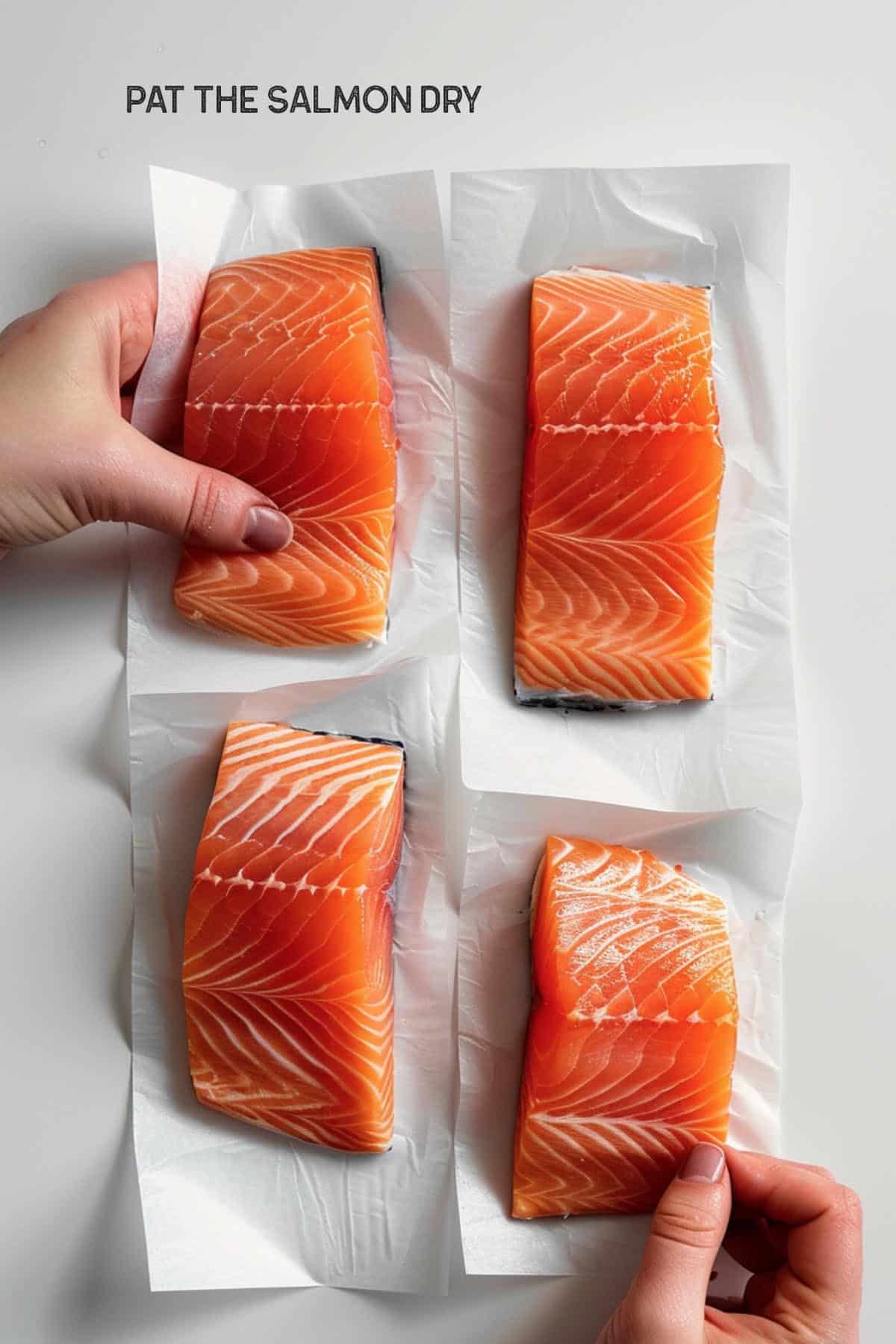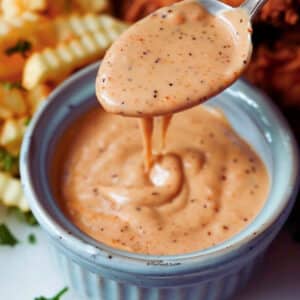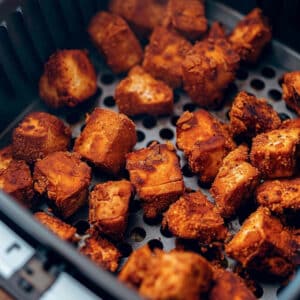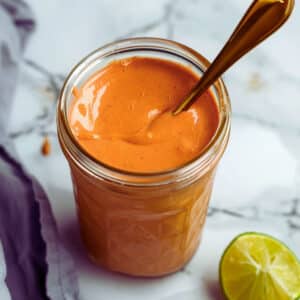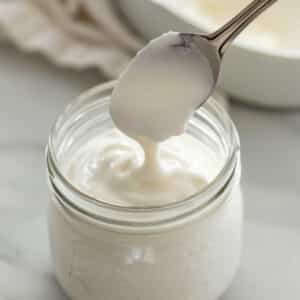Tender, flavorful salmon is within your reach! Baking is the foolproof way to cook this delicious fish perfectly. This guide will teach you everything you need to know – from choosing the right salmon to getting that irresistible crispy skin. You won't believe how easy it is to make delicious oven-baked salmon. Seriously, it'll be your new favorite!
Quick Overview:
- Prep: Preheat the oven to 400°F (200 °C) and line your baking sheet.
- Season: Pat your salmon dry and season generously.
- Aromatics (Optional): Add lemon slices, herbs, or veggies for extra flavor.
- Bake: Cook for 12-15 minutes or until salmon flakes easily with a fork.
Jump to:
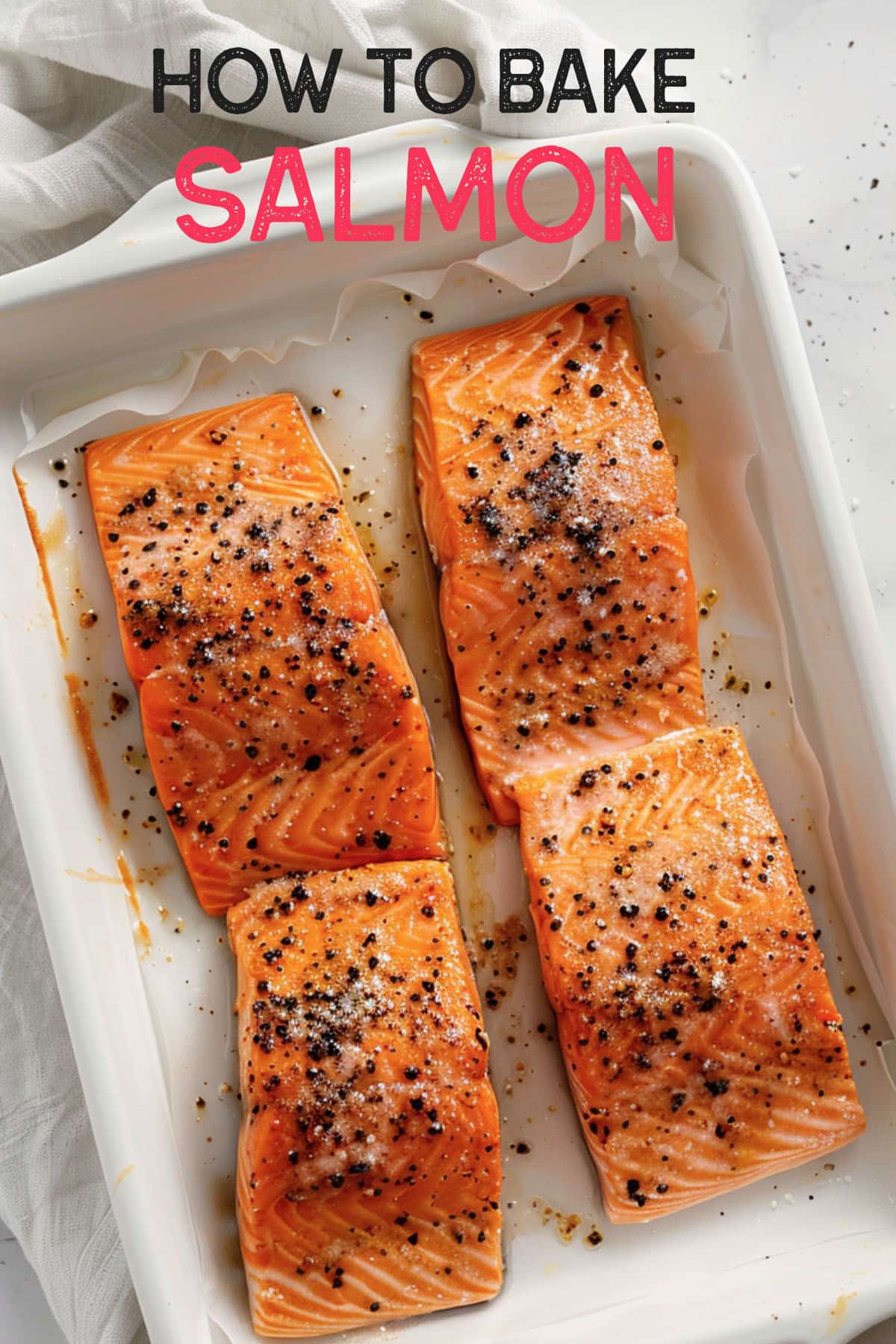
Choosing Your Salmon
- Types: Explore the world of salmon! Consider Atlantic, Sockeye, King, Coho, and more. Research their unique flavor profiles and availability in your area.
- Farmed vs. Wild: Learn the differences in taste, texture, and sustainability practices between farmed and wild-caught salmon to make an informed decision.
- Fillets vs. Whole Fish: Fillets are easier and more common. A whole salmon is visually impressive and allows additional cooking options (like stuffing!)
- Freshness Factors: Seek out firm, vibrant flesh with no signs of dullness or bruising. The salmon should have a mild, clean ocean smell.
Flavor Enhancers
The Basics:
- Olive Oil: Creates a base for seasonings to adhere and helps promote browning.
- Salt & Pepper: The foundation of deliciousness – don't skimp!
- Lemon: A squeeze of lemon juice offers a delightful touch of brightness.
- Garlic: Minced garlic adds savory depth to any salmon dish.
- Fresh Herbs: Dill, parsley, thyme, basil… experiment and find your favorites!
Creative Additions:
- Spices: Paprika, chili powder, cumin, coriander... spice things up to your liking!
- Sweeteners: A touch of maple syrup or honey pairs beautifully with salmon.
- Mustard: Dijon or whole grain mustard adds flavor complexity.
- Soy Sauce: A base for delicious Asian-inspired salmon dishes.
How to Bake Salmon in the Oven (Step-by-Step)
Preheat and Prep. Oven Temperature: 400°F (200°C) is a reliable starting point, but it can be adjusted slightly depending on desired results and fillet thickness.
Prep Your Pan. Choose whether to use parchment paper, aluminum foil, or just a lightly greased baking sheet.
Pat Dry. Remove excess moisture from the salmon with paper towels for better seasoning adherence and browning.
Oil and Season. Place the salmon skin-side down in a roasting pan. Drizzle a small amount of oil over each salmon fillet. Use your fingers or a pastry brush to evenly coat the surface. Season generously with salt and pepper.
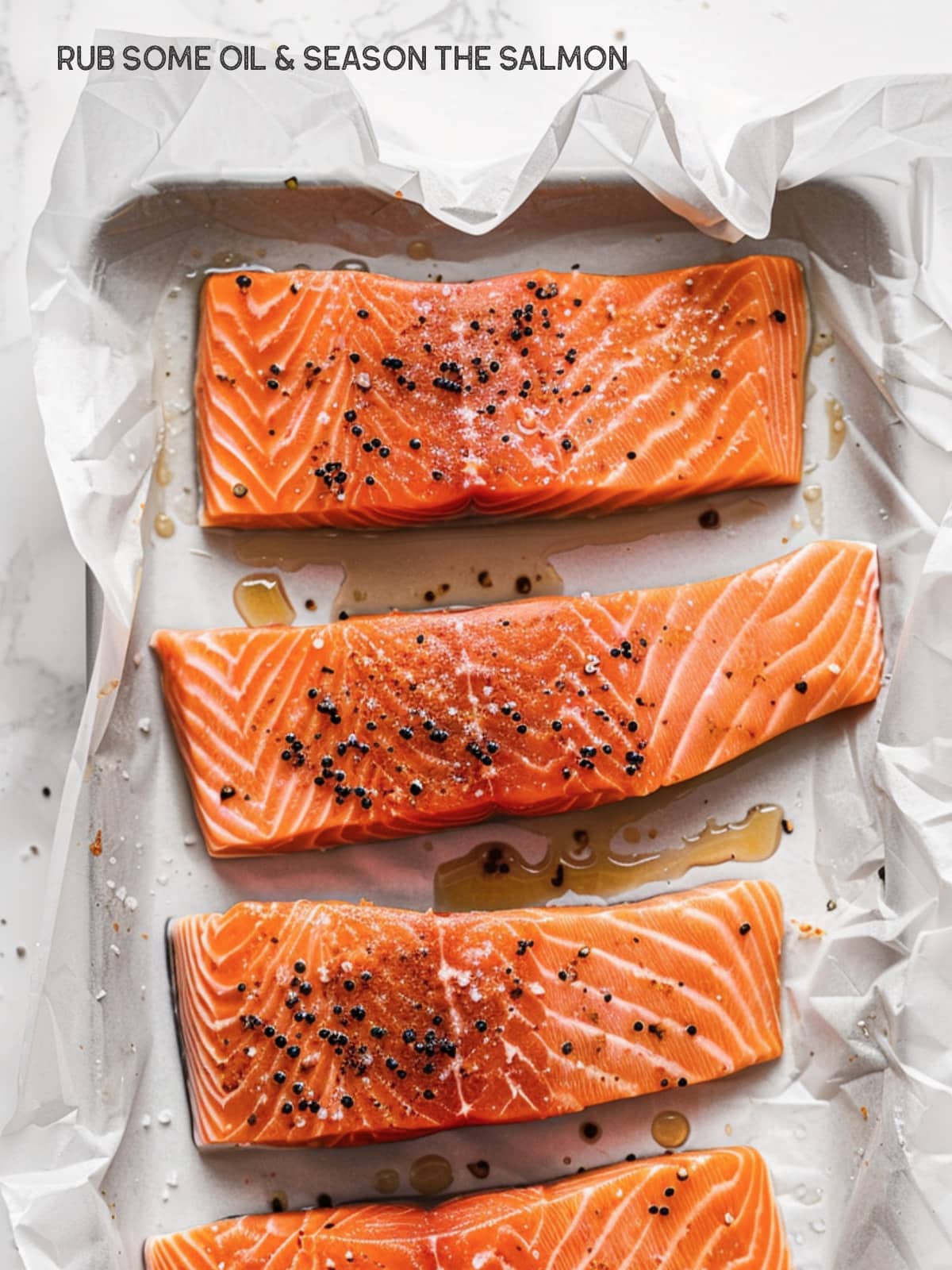
Bake the Salmon. Transfer to the oven. Bake for approximately 10 minutes per inch of thickness, measured at the thickest part of the fillet. For example, a 1-inch fillet at 400°F typically takes 12-15 minutes.
Let the Salmon Rest. Let it Rest. Remove your salmon from the heat and allow it to rest for 5 minutes. This crucial step ensures several things:
Even Doneness: Heat continues to distribute throughout the fillet, preventing overcooked edges and a raw center.
Juiciness: Resting lets the salmon's juices reabsorb into the flesh, resulting in a succulent, not dry, final product.
Tips and Variations
Skin On or Off:
- Skin On: Promotes moisture and helps the fish hold its shape. If desired, crisp the skin separately under a broiler after baking.
- Skin Off: Allows the seasonings to flavor the flesh directly.
Foil Wrapping:
- Creates Steam: This helps the fish retain moisture and is excellent for flakier varieties. Add herbs, lemon slices, and a little oil or butter inside the foil packet.
Post-Baking Steps
Resting:
- Why Rest: Allowing cooked salmon to rest for 5-10 minutes helps redistribute the juices, leading to a more tender and flavorful result.
- How: Remove the baking dish from the oven and cover loosely with foil to keep warm while resting.
Flavor Combinations:
- Herb & Citrus: Dill, lemon zest, and a pinch of red pepper flakes.
- Mediterranean: Garlic, oregano, lemon wedges, a drizzle of olive oil.
- Sweet & Spicy: Brown sugar, chili powder, paprika, and garlic powder.
Optional: Adding Aromatics
- Lemon Slices: Place thin slices under the salmon for a subtle citrus flavor.
- Fresh Herbs: Tuck sprigs of rosemary, thyme, or other herbs around the fish.
- Vegetables: Create a bed of sliced onions, fennel, or bell peppers. The salmon will cook in their flavorful juices.
Storage and Leftovers
- Cooling and Storing: Let salmon cool completely before placing it in an airtight container in the refrigerator. It should be kept safely for 3-4 days.
Reheating:
- Oven: Place salmon on a foil-lined baking sheet and reheat in a low oven (around 275°F / 135°C) until warmed.
- Stovetop: Heat a small amount of oil or butter in a skillet and gently warm salmon over low heat.
Baking Techniques and Timing
The Best Temperature to Bake Salmon
- 400°F (200°C): A great starting point, it reliably cooks salmon through while still maintaining a tender and juicy texture.
- Lower Temperature (350°F/175°C): Ideal for very thick fillets, or if you prefer a slightly softer, almost melt-in-your-mouth texture. Cooking time will be slightly longer.
- Higher Temperature (450°F/230°C): Use for thinner fillets when you want crispier skin (if applicable) and fast cooking. Pay extra attention to avoid overcooking.
How Long to Cook Salmon in the Oven
- The 10-Minute Rule: A general guideline is approximately 10 minutes of baking per inch of thickness. A 1-inch fillet at 400°F often takes around 12-15 minutes.
- Factors Affecting Time: Thickness is key, but also fillet shape (wider vs. narrow), starting temperature (fridge vs. room temp), and oven variations.
- Don't Rely on Time Alone: Always use visual cues and a thermometer for accurate results.
Desired Doneness
- Medium-Rare (125°F/52°C): The center will be a deep pink, very juicy, and have a slightly soft texture. Popular with many salmon lovers!
- **Medium (140°F/60°C): ** Most of the center will be opaque, salmon will be tender and flake easily. A common choice.
- Well-Done (145°F/63°C): Fully opaque throughout with a firmer texture. While less juicy, some still prefer it this way.
Signs of Perfection
- Flaking: An easily flaked fillet is a good sign but not foolproof. Some types of salmon flake less dramatically, even when perfectly cooked.
- Opacity: Most of the center should be opaque, with a slightly deeper pink line visible in the center for medium-rare.
- Thermometer is Key: An instant-read thermometer inserted into the thickest part of the salmon is the most reliable way to ensure your desired doneness.
Remember: Ovens vary slightly, and salmon fillets aren't perfectly uniform. The best way to nail the perfect bake is through experience, these guidelines, and using your senses!
Glazes and Toppings:
1 Honey Mustard:
- Ingredients: Dijon mustard, honey, a touch of lemon juice, salt and pepper.
- Flavor Profile: Sweet, tangy, and slightly savory.
- Instructions: Whisk ingredients together and brush over salmon during the last few minutes of baking.
2 Teriyaki:
- Ingredients: Soy sauce, Mirin (sweet rice wine), sake (or substitute with white wine), brown sugar, and a touch of grated ginger. Check the teriyaki sauce recipe here.
- Flavor Profile: Sweet and savory with a hint of umami.
- Instructions: Simmer ingredients until slightly thickened, brush over salmon during the last 5-10 minutes of baking for a sticky glaze.
3 Maple-Soy:
- Ingredients: Maple syrup, soy sauce, rice vinegar, garlic powder, and a pinch of red pepper flakes (optional).
- Flavor Profile: Sweet, salty, with a subtle warmth.
- Instructions: Combine ingredients and brush onto salmon throughout the baking process to build layers of flavor.
Beyond Glazes: Crunchy and Flavorful Toppings
1 Panko-Herb Crust:
- Ingredients: Panko breadcrumbs, fresh herbs (like dill, parsley, or thyme), grated Parmesan cheese, melted butter, salt and pepper.
- Flavor Profile: Crunchy, herby, and lightly cheesy.
- Instructions: Combine ingredients and press onto salmon fillets before baking.
2 Brown Sugar-Pecan Crumble:
- Ingredients: Chopped pecans, brown sugar, ground cinnamon, all-purpose flour, melted butter.
- Flavor Profile: Nutty, sweet, with a touch of spice.
- Instructions: Mix ingredients into a crumble and sprinkle over salmon fillets halfway through baking.
3 Citrus and Herb Gremolata
- Ingredients: Chopped fresh parsley, lemon zest, garlic, and a drizzle of olive oil.
- Flavor Profile: Bright, herbaceous, and zesty.
- Instructions: Prepare this simple topping by combining chopped ingredients, and sprinkle it over the baked salmon before serving for a burst of freshness.
Pro Tips:
- Apply glazes in the later stages of baking to prevent burning.
- Toppings often work best with thicker fillets to avoid the salmon becoming overcooked.
- Get creative! Mix and match flavors for your own unique, delicious combinations.
The Best Salmon to Buy
Types of Salmon: A Flavor Exploration
- King (Chinook): Considered the king for a reason! It boasts the highest fat content, resulting in a rich, buttery texture and melt-in-your-mouth feel. It has a deep, flavorful profile that many adore.
- Sockeye (Red): Known for its vibrant red flesh and bold, slightly "fishy" flavor. It's leaner than King but still packs healthy fats with a firmer texture. Excellent for grilling, smoking, or showcasing in salmon burgers.
- Coho (Silver): Milder flavor and often lighter in color than Sockeye. It has a delicate texture and a less pronounced "salmon" taste, making it approachable for those who prefer mellower fish.
- Atlantic: The most common commercially farmed salmon, Atlantic salmon has a mild flavor and a slightly fattier texture than its wild counterparts.
- Pink (Humpback): The smallest and most abundant Pacific salmon has a pale pink color and a mild flavor. Pink salmon is most often found canned or smoked and is an economical option.
Farmed vs. Wild-Caught: Understanding the Differences
- Taste & Texture: Farmed salmon tend to have a higher fat content due to their controlled diet, leading to a richer, softer texture. Wild-caught salmon have a leaner, firmer texture and a more pronounced "salmon" flavor profile.
- Sustainability: Wild-caught salmon, particularly from well-managed fisheries, are often favored for their sustainability practices. Farmed salmon has faced concerns about environmental impact, but responsible farming practices are increasingly being implemented.
- Cost: Wild-caught salmon typically command a higher price due to limited supply and more labor-intensive harvesting methods.
Tips for Buying the Freshest Salmon
- Appearance: Look for bright, firm flesh with no signs of bruising or discoloration. The skin should be shiny and vibrant.
- Smell: Fresh salmon should have a mild, sea-like scent and not smell overly fishy or unpleasant.
- Source: Reputable fishmongers or markets are the best bet for the freshest salmon. If buying frozen, opt for vacuum-sealed fillets that show no signs of freezer burn.
- Wild vs. Farmed: When considering farmed salmon, look for certifications like the Aquaculture Stewardship Council (ASC), which signifies responsibly farmed fish.
Remember, the best type of salmon depends on your taste preferences and how you plan to prepare it. Exploration is key!
Six More Ways to Cook Salmon:
Let's explore the diverse ways to cook salmon and the delicious results each method yields:
1 Pan-Searing:
Technique: Salmon fillets are cooked skin-side down (if applicable) in a hot skillet with a bit of oil until crispy and golden brown, then flipped to finish cooking through.
Flavors & Textures: Pan-searing creates an incredibly flavorful, crispy skin with a tender, flaky interior. The high heat caramelizes the salmon, giving it a slightly sweet, nutty flavor.
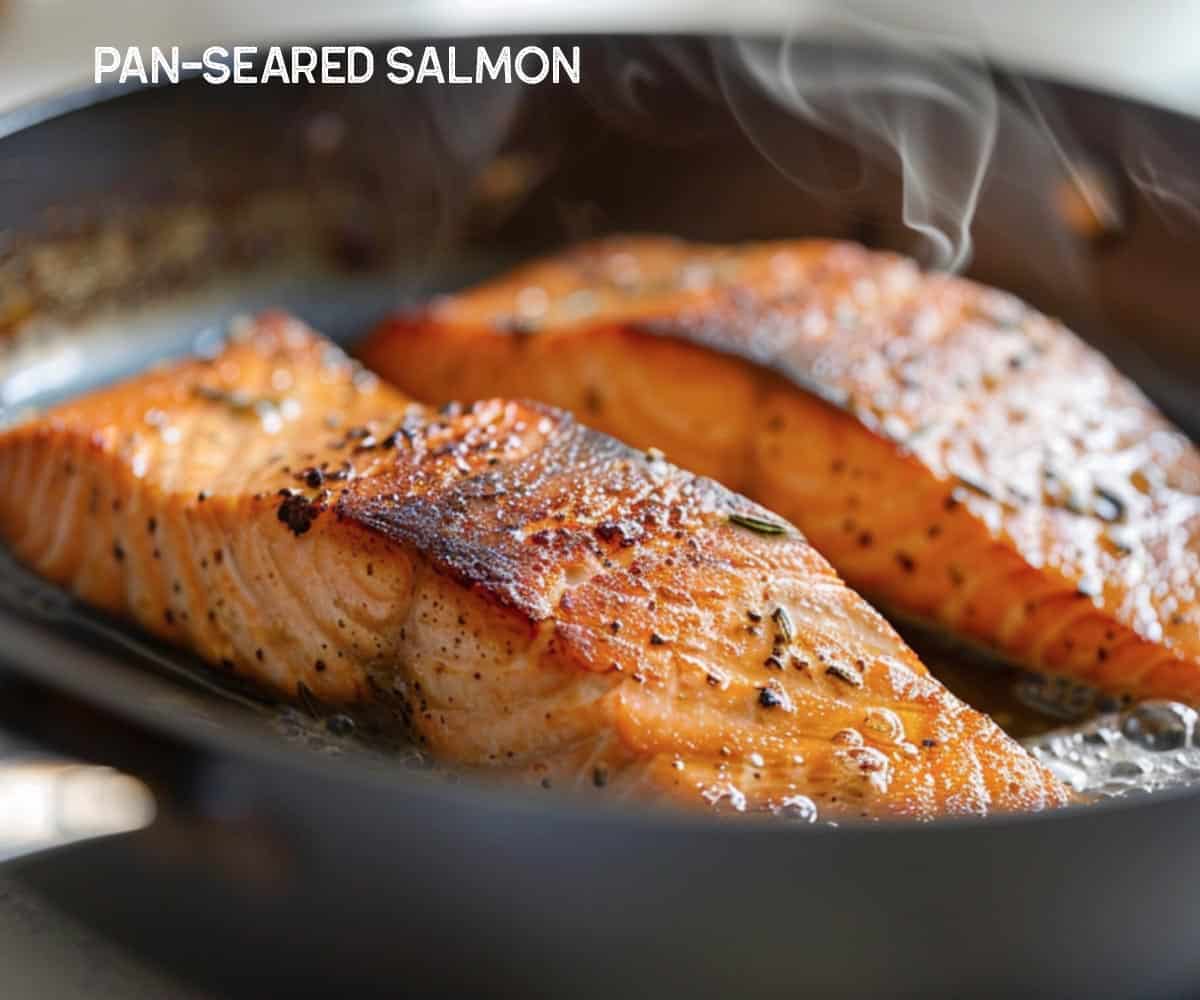
2 Grilling:
Technique: Salmon is cooked directly over the grates of a preheated grill. Skin-on fillets work best to help prevent sticking.
Flavors & Textures: Grilling imparts a delicious smoky flavor to the salmon and creates beautiful sear marks. The texture ranges from flaky to slightly firm, depending on how long you cook it.
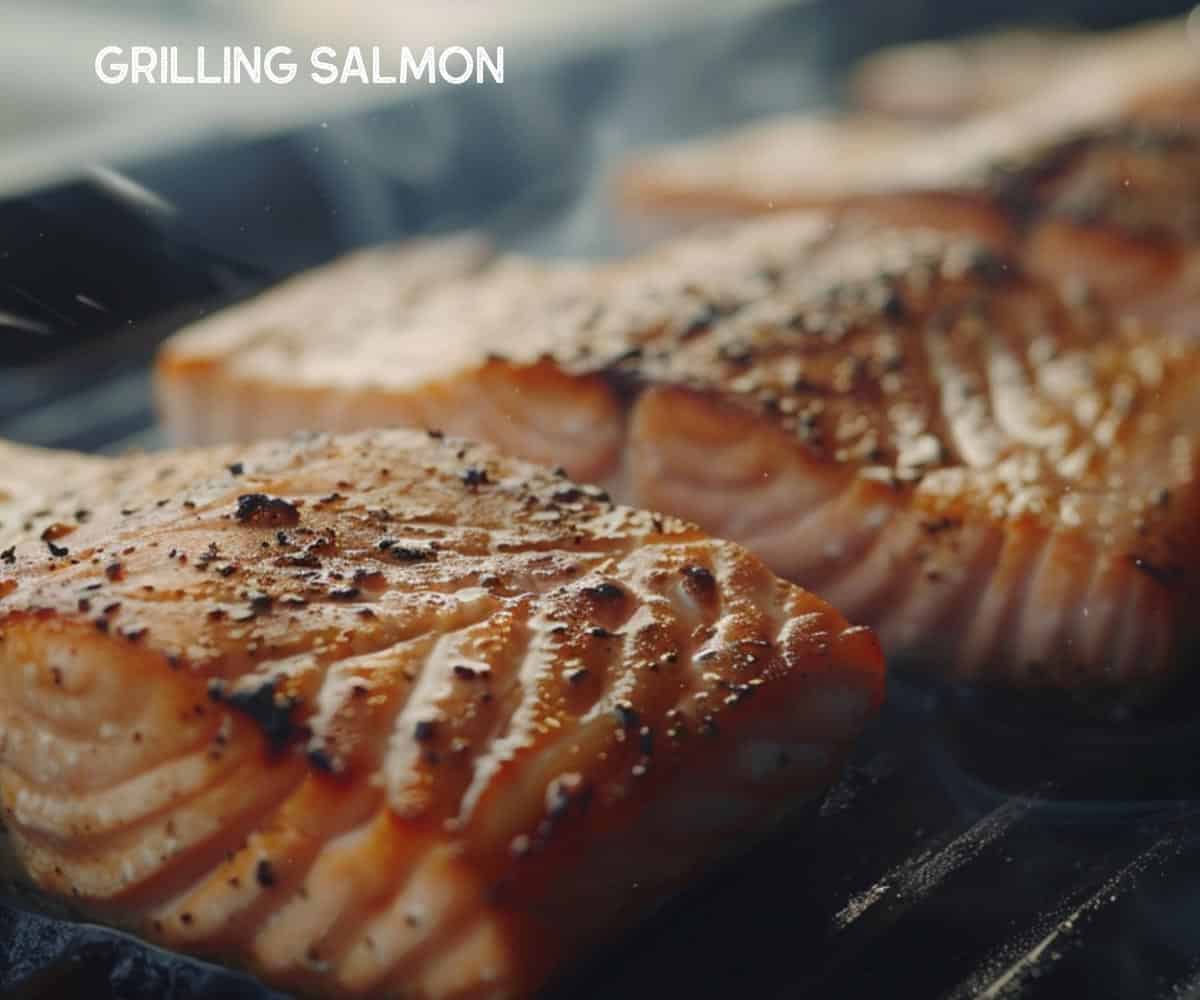
3 Poaching:
Technique: Salmon is gently simmered in a flavorful liquid like broth, milk, wine, or water with herbs and aromatics.
Flavors & Textures: Poaching is a delicate cooking method that produces incredibly moist and tender salmon. The flavors are more subtle, infused with the poaching liquid. This is an excellent choice for a light and healthy preparation.

4 Air Frying
Technique: Seasoned salmon fillets or portions are placed in the basket of an air fryer. Hot air circulates rapidly around the salmon, cooking it quickly and evenly. A light spray of oil is often used to promote crisping. Want to learn more about air fryer salmon? Check out our full guide here.
Flavor and Texture: Provides a moist interior with a crispy exterior, especially on the skin. Flavors are similar to baked salmon, depending on seasoning, but the cooking time is often shorter. Can be a slightly healthier alternative to pan-frying due to less oil needed.

5 Roasting (In a Separate Pan):
Technique: Salmon fillets or a whole side of salmon is placed in a roasting pan and baked in the oven. Often, vegetables are roasted alongside for a complete meal.
Flavors & Textures: Roasting results in a tender, flaky salmon with a slightly browned exterior. Depending on the temperature and time, you can achieve varied degrees of doneness and textures. This method is incredibly versatile for adding aromatics both under and around the salmon, infusing it with delicious flavors.
6 Sous Vide
Technique: Vacuum-sealed salmon is cooked in a precisely controlled water bath at a low temperature for an extended time.
Flavor and Texture: Subtly seasoned, allowing the pure flavor of the salmon to shine. Buttery-soft, melt-in-your-mouth texture with even doneness throughout.
Remember, the best cooking method depends on your desired results and the cut of salmon you're using. Don't be afraid to experiment and find your favorites!
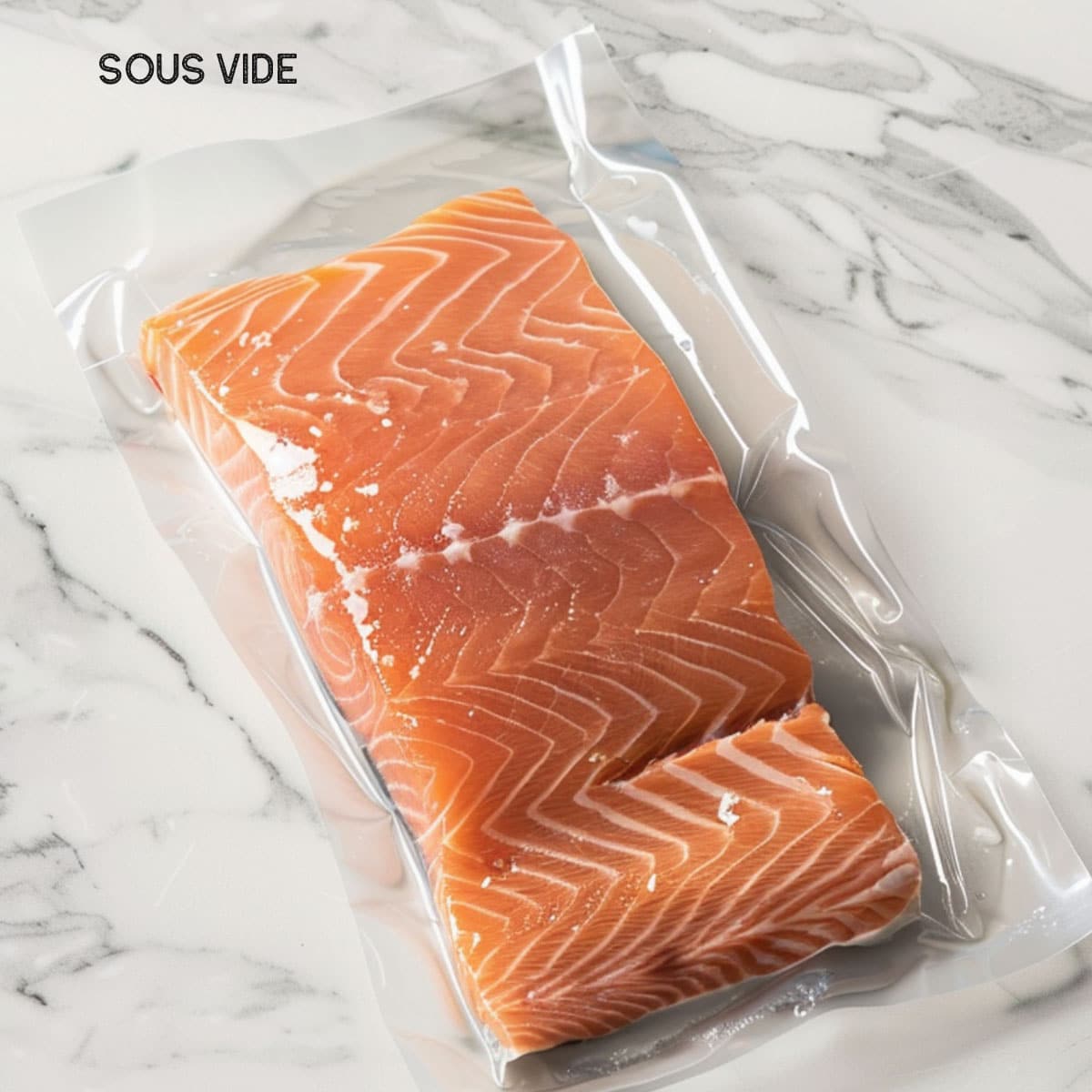
Serving Suggestions:
Let's dive into specific serving suggestions with complementary sauces to create a complete and delicious meal:
1 Roasted Asparagus with Lemon and Garlic
- The Dish: Crisp-tender asparagus spears, roasted with olive oil, minced garlic, a squeeze of lemon juice, and a sprinkle of salt and pepper. This offers a vibrant green side dish bursting with bright flavors.
- Complementary Sauce:
- Hollandaise: A classic, buttery, and slightly tangy sauce that beautifully complements both asparagus and salmon.
- Lemon-Herb Butter: A simple melted butter infused with fresh herbs like dill or parsley and a touch of lemon juice.
2 Quinoa Salad with Mediterranean Flavors
- The Dish: Fluffy quinoa tossed with chopped cucumber, tomatoes, Kalamata olives, crumbled feta cheese, fresh mint, and a lemon-based vinaigrette. This salad is packed with fresh, zesty flavors.
- Complementary Sauce:
- Tzatziki: A creamy yogurt-based sauce with cucumber, dill, and garlic. Its cool, tangy flavor complements the salad and the richness of the salmon.
- Tahini Sauce: A drizzle of nutty tahini sauce adds earthy depth to the dish and pairs beautifully with the Mediterranean ingredients in the salad.
3 Simple Arugula Salad with Balsamic Dressing
- The Dish: Peppery arugula leaves tossed with a classic balsamic vinaigrette (balsamic vinegar, olive oil, Dijon mustard, salt, and pepper). Simple and elegant, allowing the salmon flavors to shine.
- Complementary Sauce:
- Lemon Dill Aioli: A creamy aioli infused with lemon and dill, this sauce adds richness and brightness to the dish.
- Pesto: The herby, garlicky flavors of pesto work wonderfully with salmon and complement the simple salad.
Additional Tips
- Consider the Glazes/Toppings: Choose side dishes and sauces that harmonize with the flavors you've already introduced to the salmon. For instance, sweet glazes pair well with earthy vegetables, while tangy glazes can complement bolder salads.
- Seasonal is Best: Let the season guide your choices! Fresh, in-season produce will take your side dishes to the next level.
- Texture Play: Add textural contrast to the meal - the flaky salmon against crisp vegetables or the soft quinoa with crunchy cucumbers offers a satisfying balance.
Tips and Troubleshooting:
1 Overcooked, Dry Salmon
- Problem: The most common offense! Overcooked salmon is dry, tough, and loses its beautiful flakiness.
- Prevention:
- Use a thermometer: Insert an instant-read thermometer into the thickest part of the salmon. Aim for 125°F (52°C) for medium-rare or 140°F (60°C) for a more well-done center.
- Pay attention to visual cues: Look for opacity and easy flaking with a fork.
- Carryover Cooking: Remove the salmon from the heat source a few minutes before it reaches your desired doneness, as it will continue to cook slightly off the heat.
- Salvage Tactics:
- If slightly dry, a drizzle of flavorful sauce or melted butter can help.
- For severely overcooked salmon, consider flaking it and using it in a salmon salad, dip, or chowder where dryness will be less noticeable.
2 Undercooked Salmon
- Problem: Undercooked salmon can have an unappealing soft, mushy texture and may pose food safety concerns.
- Prevention:
- Follow general cooking time guidelines, but always check for visual doneness cues and use a thermometer for accuracy.
- Salvage Tactics: Unfortunately, for the best texture and food safety reasons, it is advisable to return the salmon to the heat source (oven, pan, etc.) and finish cooking it completely.
3 Stuck in the Pan
- Problem: A frustrating issue, often leading to torn salmon skin or fillets that break apart.
- Prevention:
- Hot Pan, Cold Oil: Ensure your pan is preheated before adding a bit of oil. The hot surface helps create a natural nonstick barrier.
- Skin-on: Cook skin-side down first and allow it to crisp up before attempting to flip.
- Don't Disturb: Avoid moving the salmon too early in the cooking process. Let it sear; it will naturally release from the pan when ready.
- Salvage Tactics:
- If the salmon is still raw after sticking, a thin spatula carefully worked underneath can help free it.
- For torn pieces, consider pivoting your presentation towards a flaked salmon dish.
4 Bland Flavor
- Problem: Lackluster seasoning or under-developed flavors can leave your salmon underwhelming.
- Prevention:
- Season generously with salt and pepper before cooking.
- Get creative with herbs, spices, and aromatics (garlic, lemon, etc.).
- Consider a flavorful glaze or sauce.
- Salvage Tactics:
- Serve with a vibrant sauce on the side for a boost.
- A sprinkle of flaky sea salt and a squeeze of lemon can sometimes salvage a bland dish.
Always remember, practice makes perfect! With a little attention, these pitfalls are easily avoided, leading to consistently delicious salmon dishes.
Full Recipe
How to Bake Salmon
Pin RecipeEquipments:
- baking sheet or roasting pan
- parchment paper or aluminum foil
Ingredients:
- 2 lbs Salmon fillet
- ½ tablespoon salt
- ½ tablespoon pepper
- 1 tablespoon olive oil
Instructions:
- Preheat and Prep. Oven Temperature: 400°F (200°C) is a reliable starting point, but it can be adjusted slightly depending on desired results and fillet thickness. (see notes*)
- Prep Your Pan. Choose whether to use parchment paper, aluminum foil, or just a lightly greased baking sheet.
- Pat Dry. Remove excess moisture from the salmon with paper towels for better seasoning adherence and browning.
- Oil and Season. Place the salmon skin-side down in a roasting pan. Drizzle a small amount of oil over each salmon fillet. Use your fingers or a pastry brush to evenly coat the surface. Season generously with salt and pepper.
- Bake the Salmon. Transfer to the oven. Bake for approximately 10 minutes per inch of thickness, measured at the thickest part of the fillet. For example, a 1-inch fillet at 400°F typically takes 12-15 minutes. (see notes*)
- The best way to tell if your salmon is done is the flake test! Gently poke it with a fork – if it breaks into beautiful flakes, it's ready to enjoy. For those who like extra reassurance, an instant-read thermometer is your friend. Aim for 145°F at the thickest part of the fillet.
- Let it Rest. Remove your salmon from the heat and allow it to rest for 5 minutes. This crucial step ensures several things:Even Doneness: Heat continues to distribute throughout the fillet, preventing overcooked edges and a raw center.Juiciness: Resting lets the salmon's juices reabsorb into the flesh, resulting in a succulent, not dry, final product.
- Your salmon is at its best fresh from the oven, so dig in! If you have leftovers, they'll keep for up to 3-4 days in the fridge. You can reheat them gently in the microwave or even enjoy them cold.
Notes:
The best temperature to bake salmon
- 400°F (200°C): A great starting point, it reliably cooks salmon through while still maintaining a tender and juicy texture.
- Lower Temperature (350°F/175°C): Ideal for very thick fillets, or if you prefer a slightly softer, almost melt-in-your-mouth texture. Cooking time will be slightly longer.
- Higher Temperature (450°F/230°C): Use for thinner fillets when you want crispier skin (if applicable) and fast cooking. Pay extra attention to avoid overcooking.
How long to cook salmon in the oven
- The 10-Minute Rule: A general guideline is approximately 10 minutes of baking per inch of thickness. A 1-inch fillet at 400°F often takes around 12-15 minutes.
- Factors Affecting Time: Thickness is key, but also fillet shape (wider vs. narrow), starting temperature (fridge vs. room temp), and oven variations.
- Don't Rely on Time Alone: Always use visual cues and a thermometer for accurate results.
Storage and Leftovers
- Cooling and Storing: Let salmon cool completely before placing it in an airtight container in the refrigerator. It should be kept safely for 3-4 days.
Reheating:
-
- Oven: Place salmon on a foil-lined baking sheet and reheat in a low oven (around 275°F / 135°C) until warmed.
- Stovetop: Heat a small amount of oil or butter in a skillet and gently warm salmon over low heat.
Nutrition Information:
Please note that all nutrition information are just estimates. Values will vary among brands, so we encourage you to calculate these on your own for most accurate results.

